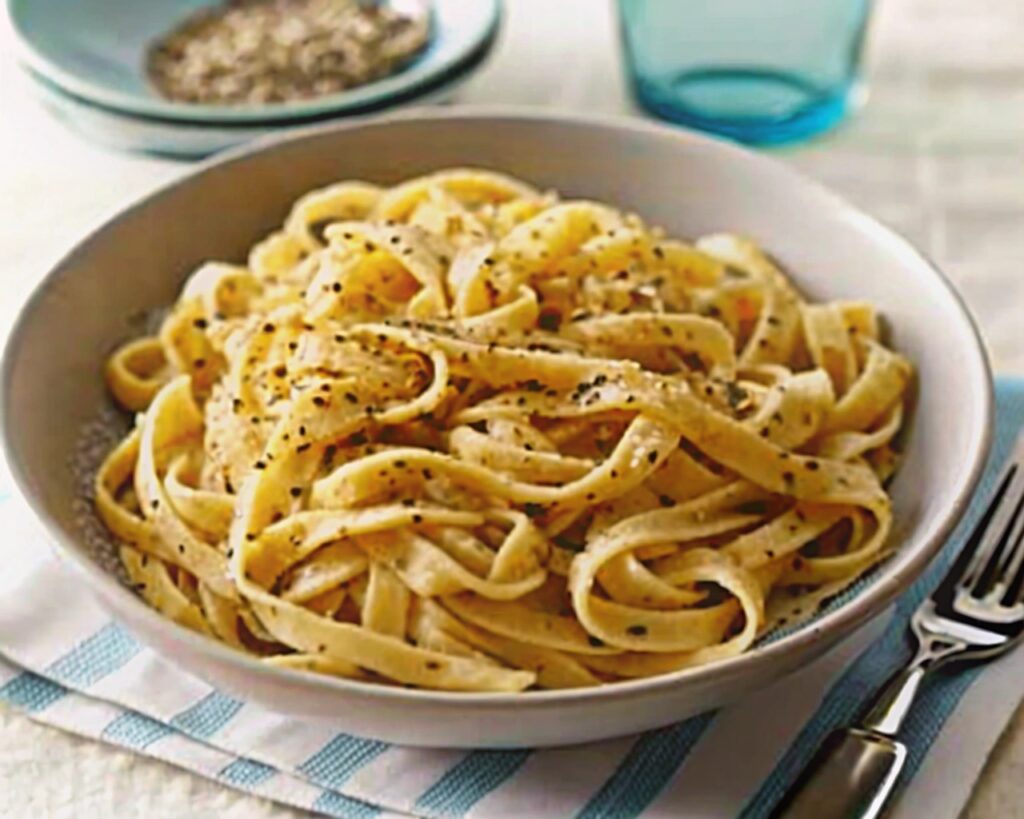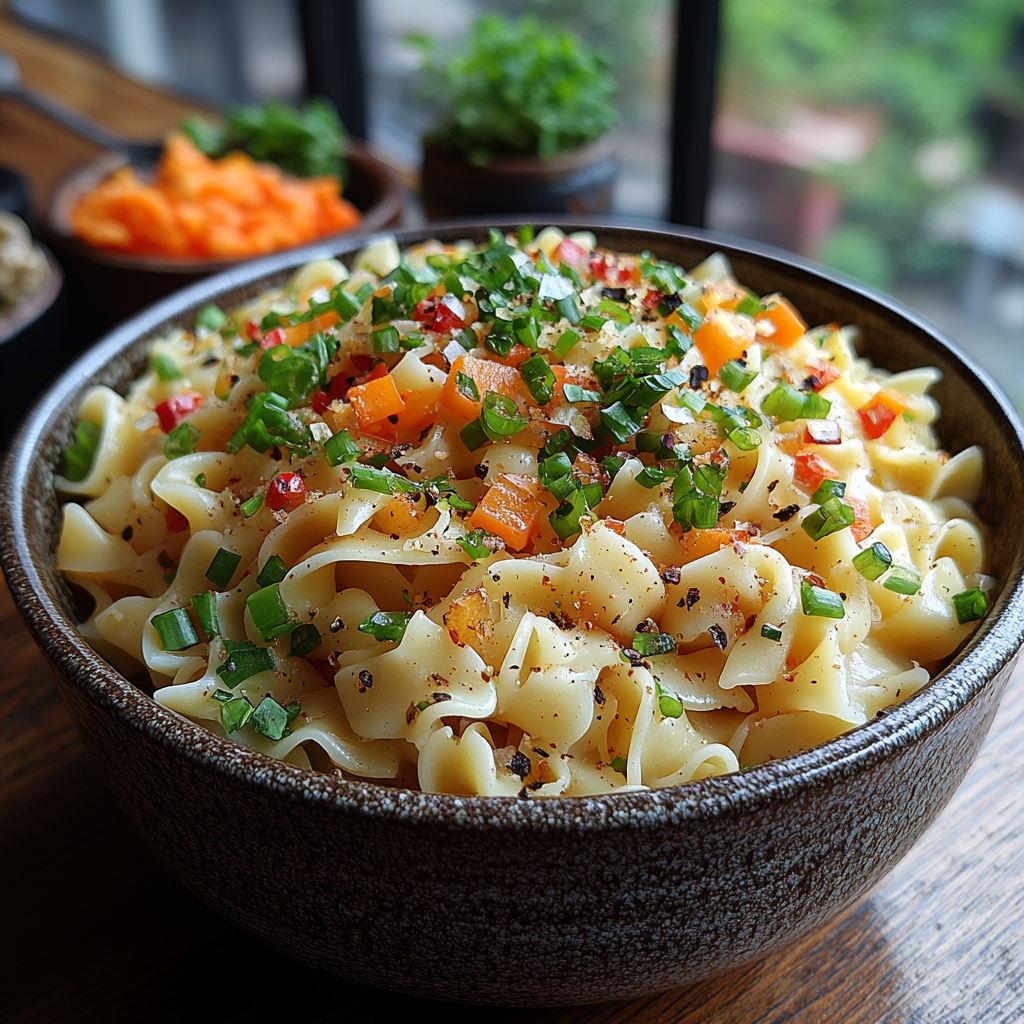Egg noodles are a beloved staple in kitchens around the world. From homemade egg noodles to store-bought options, these versatile strands are the base for many comforting meals. In this guide, we’ll explore every aspect of egg noodles, from crafting the perfect dough to serving up delightful recipes like chicken noodle soup and Swedish meatballs. Let’s dive into the art of making, cooking, and enjoying egg noodles.
Essential Ingredients for Egg Noodle recipes
When it comes to making egg noodles, simplicity is key. With just a handful of essential ingredients, you can create delicious, homemade noodles that elevate any dish. Here’s a closer look at the fundamental components you’ll need to prepare perfect egg noodles:
All-Purpose Flour
The backbone of your noodle dough, all-purpose flour provides the necessary structure and texture. For the best results, opt for high-quality flour, such as Bob’s Red Mill’s Organic Unbleached White All-Purpose Flour. Its versatility makes it suitable for a wide range of recipes, including egg noodles. Unlike bread flour, which has a higher protein content, all-purpose flour strikes the right balance for achieving the springy, chewy texture characteristic of delightful egg noodles.
Eggs
Eggs are the star ingredient in egg noodles, providing richness, flavor, and color. Fresh, high-quality eggs will improve the taste and texture of your noodles significantly. The number of eggs used can vary depending on the recipe, but they are crucial for creating that signature silky mouthfeel.
Explore more about cooking with eggs in Egg Recipes.
Salt
A small amount of salt is added to enhance the flavor of the dough. While it’s not a prominent ingredient, salt is essential for bringing out the natural flavors of the eggs and flour. Additionally, you’ll use salt when boiling the noodles, which helps to season them as they cook.
Water
While some recipes may not specify water, adding a bit can help achieve the desired dough consistency. The amount of water needed can vary, so it’s important to incorporate it gradually until the dough comes together without being overly sticky.
Cornstach
Although cornstarch is not an ingredient in the noodle dough itself, it plays a vital role in preventing the cooked noodles from sticking together. A light dusting of cornstarch ensures that your freshly made noodles can be easily separated and served.
Having these essential ingredients on hand is all you need to embark on your homemade egg noodle journey. With just a bit of practice, you’ll find that the time spent making your own noodles is well worth the effort, delivering a fresh taste that far surpasses store-bought options. Whether you enjoy them simply buttered or tossed with your favorite sauce, homemade egg noodles are sure to impress!
Tips for Choosing Quality Eggs
Using fresh eggs is crucial for achieving the best texture and flavor. Look for eggs with:
- Vibrant yolks, which produce noodles with a golden color.
- A firm consistency, ensuring they bind well with flour.
For extra richness, some recipes call for egg yolks only, so be sure to have a mix of whole eggs and yolks handy.
The Right Flour Ratios: Key to Perfect egg Noodle recipes
The Importance of Flour Ratios
When it comes to making homemade egg noodles, the correct flour-to-liquid ratio is crucial for achieving the desired texture and consistency. This balance is vital as it influences the chewiness, elasticity, and overall flavor of your noodles.
Choosing the Right Flour
In this recipe, the foundation is built on 2 to 2½ cups of all-purpose flour, which is suitable for creating a versatile noodle that pairs wonderfully with various sauces and dishes. Using all-purpose flour gives your noodles a nice balance of structure and tenderness, making them perfect for everything from hearty chicken noodle soup to a simple marinara.
Adjusting for Variability
However, it’s important to note that the exact amount of water needed may vary based on several factors. These include the type of flour used, the size of the eggs, and even the humidity and temperature of your environment. For instance, if you opt for a finer flour like 00 flour, often used in traditional pasta-making, you may find that it requires slightly less water.
The original recipe calls for 6 tablespoons of water to accompany your flour and eggs, serving as an excellent starting point for creating a firm dough. If the dough feels too dry or difficult to work with, you can gradually add more water by the teaspoon until the desired consistency is achieved. Conversely, if your dough appears too sticky, incorporate a bit more flour to help regain the right texture.
Learn about recipes that creatively use flour in Elote Pasta Salad.
Enhancing Flavor with Quality Ingredients
Additionally, using high-quality eggs, such as those sourced from small family-run farms, can significantly enhance the flavor and color of your noodles. The vibrant yolks of organic free-range eggs contribute a rich hue and taste that elevates your homemade noodles above store-bought options.
Customizing Your Noodles
Ultimately, mastering the right flour ratios will empower you to tailor your noodles to your personal preference. Whether you like them thin and delicate or thick and hearty, experimenting with different flour types and hydration levels will help you discover the perfect noodle texture for your next culinary creation. With a bit of practice, you may never want to return to pre-packaged noodles again!
Achieving the ideal noodle texture requires careful attention to the ratio of flour to eggs. Generally, one cup of flour pairs well with one large egg, though you may adjust based on humidity and desired thickness. Keep additional flour nearby to adjust consistency as needed.

Step-by-Step Guide to Making Egg Noodles
Dough Preparation: The Foundation
The dough is the heart of any noodle recipe. Here’s how to prepare it:
- Mix Ingredients: In a mixing bowl, combine flour and eggs. Use a dough hook if available for a smooth consistency.
- Knead: Turn out the mixture onto a clean work surface and knead until it forms a soft dough ball.
- Rest: Wrap the dough in plastic wrap and let it rest for 30 minutes. This step allows gluten to develop, resulting in elastic dough.
Rolling Techniques for Uniform Noodles
Rolling dough evenly ensures consistent noodle thickness. Here’s how:
- Dust your floured surface with dry flour.
- Roll dough using a rolling pin or a pasta machine, maintaining even pressure.
- Aim for thinner noodles if making delicate dishes or wider noodles for hearty meals.
Cutting Techniques: Different Shapes and Sizes
Cutting is where creativity shines. Use a pizza cutter for straight edges or experiment with special equipment for unique shapes.
- Thin strips: Ideal for soups like chicken noodle soup.
- Wide noodles: Perfect for casseroles or buttered noodles.
- Custom shapes: Fun for kids and themed dishes.
Cooking Methods for Egg Noodles
Boiling is the most common method for cooking egg noodles:
- Bring a pot of water to a rolling boil.
- Add a pinch of salt and noodles, ensuring they don’t stick.
- Cook fresh egg noodles for 2–3 minutes or until tender.
- Drain and rinse under cold water to stop the cooking process.
Serving Suggestions: Pairing Ideas
Egg noodles shine with a variety of pairings:
- Top with your favorite sauce like marinara or Alfredo.
- Toss with fresh parsley and butter for buttered noodles.
- Serve alongside meats in Swedish Meatballs or Beef Stroganoff.
Classic Recipes Featuring Egg Noodles
Beef Stroganoff: A Comforting Meal
This dish combines tender beef, creamy sauce, and hearty noodles for the ultimate comfort food.
Chicken Noodle Soup: A Family Favorite
A steaming bowl of this classic soup is perfect for cold days. Use cooked egg noodles and fresh vegetables for a wholesome meal.
Creamy Casseroles: Perfect for Any Occasion
Layer wide noodles with creamy sauces, cheese, and your choice of protein for a baked masterpiece.
Creative Variations of Egg Noodles
- Chinese egg noodles: Thin and springy, ideal for stir-fries.
- Thicker noodles: Great for soaking up robust sauces.
- Turkey Noodle Soup: A post-holiday favorite using leftover turkey.
Meal Prep Tips for Homemade egg Noodles
- Portioning: Divide noodles into meal-sized servings before storing.
- Storage: Use an airtight container to keep noodles fresh in the fridge for up to three days.
- Freezing: For longer storage, freeze noodles on a tray before transferring them to bags.
Storage Tips: Keeping Noodles Fresh
- Keep unused dough wrapped tightly to prevent drying.
- Store frozen noodles in labeled bags for easy access.
- Use a resealable airtight container for leftover cooked noodles.
Discover how meal prep can enhance your cooking in High Protein Meal Prep.
Conclusion: Embracing Homemade Egg Noodles
Making your own egg noodles is not only rewarding but also allows endless customization. Whether you’re serving up buttered noodles for a quick meal or crafting elaborate dishes like Beef Stroganoff, these versatile noodles are a joy to prepare. Start with simple ingredients and let your creativity shine in the kitchen.


2 thoughts on “The Ultimate Guide to Egg Noodle Recipes”
Comments are closed.